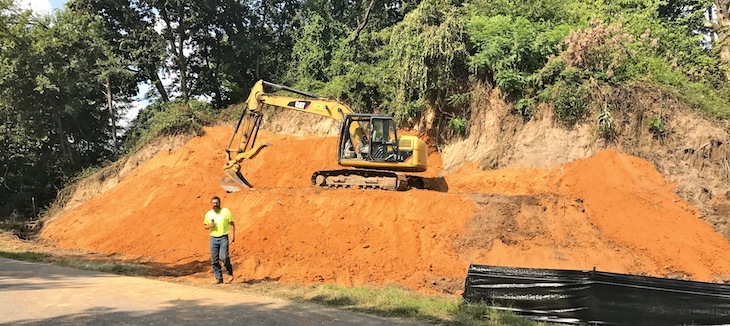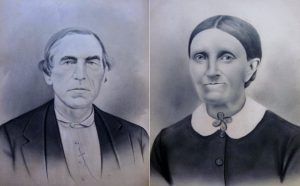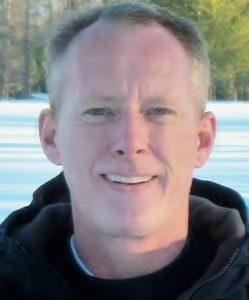Relative of family buried on Native American mound in Fort Smith pleased with restoration
by September 6, 2017 8:11 pm 2,991 views

A worker with Steve Beam Construction takes a break during restoration of the Caddo Mound in south Fort Smith.
Tim McDowell was in Fort Smith a few years ago for what was to be a simple family gravestone dedication at Oak Cemetery. But he learned as part of the event that his third great grandparents – the family’s first immigrants to the United States – were buried on top of a Native American mound in south Fort Smith.
During what was to be a brief stay in Fort Smith, McDowell said he was “aggressively researching” family tree, and with help from the genealogy department at Fort Smith Public Library learned that Heinrich and Cathrina (Vinkman) Stoppelman were buried on the mound.
“Then I told them, I have to see this place,” McDowell, who lives in the Denver metro area, told Talk Business & Politics.
He and a friend tried to get to the top of the mound, but thick vegetation near the top blocked their progress. He was able to see the damage to the east side of the historic mound.
THE MOUND
The “Cavanaugh” Mound, located behind the New Liberty Baptist Church in south Fort Smith, is believed to have been constructed by Native Americans (possibly Caddo Indian ancestors) between AD 1100 and 1300. Caddo territory once included southwestern portions of Arkansas and northeast portions of Texas. It is believed the Caddo Indians built the mound in several phases. The mound was originally about 200 feet long at the base of each of the four sides and about 40 feet tall.

Tim Mulvihill, an archeologist with the University of Arkansas system and with the Arkansas Archeological Survey, and Jessica Crawford, southeast regional director for The Archaeological Conservancy, have worked together on the project for more than a decade.
The conservancy, a private, non-profit organization formed in 1980 to acquire and preserve important archaeological sites, purchased the Cavanaugh Mound in 2006 and contracted with Steve Beam Construction to secure the site. Work, estimated to cost around $40,000, began the week of Aug. 7.
THE FAMILY LINE
Heinrich Wilhelm Stoppelmann and Cathrina (Vinkman) Stoppelmann, as McDowell said, were the first in the family line to emigrate to the United States. They acquired the Fort Smith property that included the mound.
Their daughter, Wilhelmina, married Joseph Heinrich Merk. Their son, Johann Edward Merk, married Minnie Beatty Gilmore. They had a daughter, Minnie Virginia, who married Garland McDowell. That union produced Robert McDowell, who married Bonnie Thompson. Robert and Bonnie are Tim’s parents.
Tim’s parents grew up in Muskogee, Okla., where his father was a good baseball player. McDowell said his father was tempted to make a run at the major leagues, but opted instead to earn an electrical engineering degree. Robert McDowell was working in Fort Worth for General Dynamics in the late 1960s when he decided to become a minister. After being the pastor of several churches, Robert ended up in the Denver area where he preached for around 25 years.
Tim McDowell now works in the home healthcare industry in the Denver area.
‘SLIGHT REMORSE’
McDowell also said amazing coincidence has been part of his effort to learn more about his family. About a year ago, a man from the Kansas City area contacted him to let him know that chalk portraits from a Goodwill Store were of Heinrich and Cathrina. The man, according to McDowell, would not identify himself.

Goodwill was conducting an auction on its website, and McDowell won the bid for the portraits. The portraits had been reframed, but the frame company is no longer in operation and McDowell has yet to put a date on when when the portraits were made. He’s also unsure how they ended up in a Kansas City Goodwill Store.
What he is sure of is “slight remorse” about his family being involved in using the mound for a burial plot.
“I have to admit, there was some slight remorse,” McDowell said when he learned how the family used the mound. “But a lot of times you learn in genealogy (research), that things are done out of ignorance. … They didn’t know about that (mound history). … But I had to embrace it and know it was part of our family and who we were.”
McDowell also praised the work of Crawford and Mulvihill, saying they have not only been professional in terms of restoring the mound, but in working with him to ensure family artifacts are protected.
Work on the mound was set to be complete in early September, with work then beginning to establish grass on the restored portion.
“We have not encountered any other human remains, but I’m confident there are others still there,” Mulvihill said.
